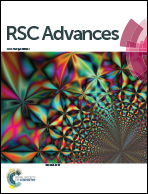Large-scale synthesis of a monophosphonated tetrathiatriarylmethyl spin probe for concurrent in vivo measurement of pO2, pH and inorganic phosphate by EPR†
Abstract
Low-field electron paramagnetic resonance spectroscopy paired with pTAM, a mono-phosphonated triarylmethyl radical, is an unmatched technique for concurrent and non-invasive measurement of oxygen concentration, pH, and inorganic phosphate concentration for in vivo investigations. However, the prior reported synthesis is limited by its low yield and poor scalability, making wide-spread application of pTAM unfeasible. Here, we report a new strategy for the synthesis of pTAM with significantly greater yields demonstrated on a large scale. We also present a standalone application with user-friendly interface for automatic spectrum fitting and extraction of pO2, pH, and [Pi] values. Finally, we confirm that pTAM remains in the extracellular space and has low cytotoxicity appropriate for local injection.



 Please wait while we load your content...
Please wait while we load your content...